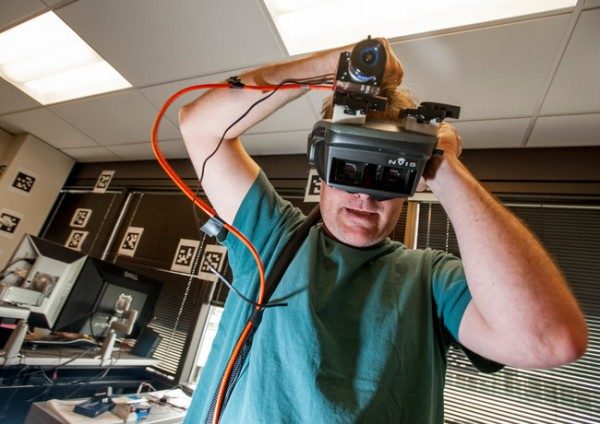
It’s no secret that Valve is internally researching virtual reality. Michael Abrash is publicly known to be Valve’s virtual reality and augmented reality researcher. Valve recently put out a job posting for an industrial designer noting that the company is frustrated with the stagnation of gaming interactivity. “Even basic input, the keyboard and mouse, haven’t really changed in any meaningful way over the years. There’s a real void in the marketplace, and opportunities to create compelling user experiences are being overlooked”, went the description of the position — yet Valve continues to deny that they are working on their own head mounted display for virtual reality games.
Nick Wingfield recently visited Valve HQ in Washington state and recounted his tales in a recent New York Times article. Apparently he got his hands on some of Abrash’s virtual reality hardware:
This is no Xbox 360 or PlayStation 3.
Every way I look, the scene shifts, the battle unfolds. I have a crazy contraption strapped to my head: a boxy set of goggles that looks like a 22nd-century version of a View-Master. It immerses me in a virtual world. I whirl one way and see zombies preparing to snack on my flesh. I turn another and wonder what fresh hell awaits.
Since the article was published there’s been speculation that the 3d head mounted display pictured in the article (and above) is of Valve’s own design. Abrash has now specifically denied that the pictured HMD was made by the company. Instead it turns out to be an $18,000 commercially available device that he’s been using to experiment with:
I’ve seen some speculation online that one of the pictures that accompanies the article… depicts a prototype of a Valve HMD. That might be more plausible if the headset didn’t clearly have the letters “NVIS” on it. It’s an off-the-shelf NVIS ST-50 see-through HMD, with a couple of mounts added and a camera mounted in one of them. It’s a useful platform to experiment on, but it’s definitely not a prototype. It’s also not a video-passthrough AR HMD, as some have guessed; it’s see-through, and the camera is used only for tracking.

The question remains though — what’s Abrash doing researching VR and AR for Valve if the company isn’t interested in making a head mounted display for virtual reality games? Abrash, who thinks that good augmented reality games are three to five years away, says that the company still hasn’t decided if they’ll make their own HMD hardware. “Gabe [the founder of Valve] has a saying, which is, ‘We will do what we need to do’… we don’t particularly want to be a company that makes hardware in large quantities. It’s not what we do,” he told the New York Times.
The article makes it sound as though Valve is doing R&D with the hope that other companies will manufacture head mounted displays based on their research. “…[Valve’s] ultimate goal is to share its designs freely so other hardware companies can make glasses, too,” reads the article. This would open up the opportunity for Valve to work in software — on virtual and augmented reality games — which has been the company’s traditional product. Whatever Valve’s plans are I’m happy to see that they’re at least doing research and clearly interested in making immersive games. Virtual reality gaming is the next step in the industry; in my book, the more people working on figuring out how to make that happen, the better.






